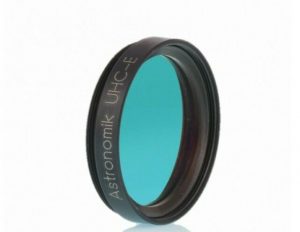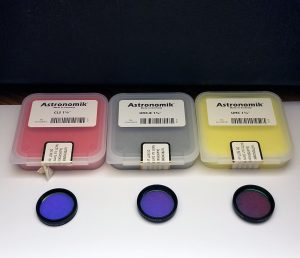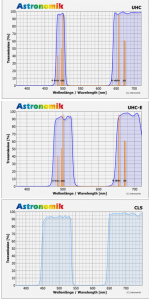For the ATT Volume 14 Issue 9, I wrote an article describing my experiences under light-polluted skies using Astronomik’s 1.25” UHC, UHC-E, and CLS filters along with the absence of a filter. The upshot of that article was that such filters prove their value by revealing many deep sky wonders in the eyepiece via light pollution mitigation.
However, gathering data for that article also included considerable time using the filters under the dark skies of my home observatory. The exercise highlighted the fact that appropriate filter(s) can be quite effective in enhancing contrast (thus, detail) for many deep sky objects regardless of light pollution conditions. This article discusses the use of the Astronomik CLS, UHC-E, and UHC filters under those darkened skies.
Filters and Light: Addition by Subtraction
Astronomical filters are designed to permit passage of select wavelengths of light. In doing so, they increase contrast (not illumination) by selectively excluding unwanted light. To repeat an analogy, we might enjoy eating a bite of salad…a pleasing blend of tastes arising from a multitude of vegetables and toppings.
Deep sky objects are like this salad in that unfiltered views provide a pleasing blend of detail across all visible wavelengths. Using a filter to isolate wavelengths of light is like pulling an individual tomato or slice of cucumber from that salad: A specific flavor, selected for attention in relative absence of competing options. You might say that filters help us tailor the view to emphasize our desired “flavors”.
Technical Details: The Filters
 Under full dark adaptation, the human eye might detect a subset of available light, with wavelengths ranging from 400 and 600 nanometers (an upper range truncated compared to daytime vision). For the CLS, UHC-E, and UHC filters (as well as others), Astronomik publishes charts that juxtapose wavelengths with percentage of light being passed through. In these charts (see Image 1), elevated portions represent wavelengths for which light passage is permitted, whereas lower portions represent wavelengths being filtered from view.
Under full dark adaptation, the human eye might detect a subset of available light, with wavelengths ranging from 400 and 600 nanometers (an upper range truncated compared to daytime vision). For the CLS, UHC-E, and UHC filters (as well as others), Astronomik publishes charts that juxtapose wavelengths with percentage of light being passed through. In these charts (see Image 1), elevated portions represent wavelengths for which light passage is permitted, whereas lower portions represent wavelengths being filtered from view.
With low amounts of light pollution from such sources as sodium- and mercury-vapor lights under my dark skies, the budget-friendly CLS filter was expected be less advantageous than the other filters. The UHC-E filter is also budget-friendly, yet is designed to further enhance contrast of emission nebulae and comets by blocking airglow along with common artificial lighting. With the UHC, blockage of select wavelengths is even more aggressive, being particularly adept at transmitting Hydrogen-beta and Oxygen-III lines while effectively blocking much background sky illumination.
Technical Details: Observing Site and Gear
Viewing for this article took place under clear, smoke-free, moonless Bortle class 4 skies. Thus, the estimated limiting visual magnitude was between 6.1 and 6.5. Suffice to say, magnitude 5.8 Messier 13 was unmistakable to the naked eye during each session.

The first session saw use of my SkyWatcher Pro 100ED refractor (100mm aperture) and Celestron AVX mount for consistency with observations under light-polluted conditions. However, I pulled out my 16” f/4.5 custom dob for the second evenings’ viewing. On the third night, I used my MallinCam VRC10-CF.
Within the three scopes, I used a range of eyepieces, including anm8mm and 10mm Tele Vue Delos, 13mm and 18.2mm TeleVue Delites, and an Orion 22mm Lanthenum Superwide. Eyepieces were selected so as to have long eye relief, roughly comparable apparent fields of view (i.e., ranging from 62 to 72 degrees), and all being solid-performing units.
Viewing under unobstructed skies enabled me to spend time on Messiers 31, 32, and 110, as well as study hydrogen emissions in Messier 33. For consistency with viewing under light-polluted skies, nebular targets for dark skies also included Messiers 8, 17, and 20.
The View: Dark, Rural Skies
Highlights from under star-filled, dark skies can be summarized as follows:
– The UHC is stated as being suitable for telescopes 100mm and larger in aperture. I would concur, as M8 and M20 were visible in my 100mm refractor, but less obvious in the UHC compared to the UHC-E. Emissions within these nebulae were most prominent with the UHC-E in the small scope.

– With the 16” dob, the UHC delivered the “WOW!” factor for both M17 and M8. For M17, differentiation in tail structure (i.e., tail “feathers”) and a “sack” around the back and undersides of the swan’s body were clearly distinguished using the 22mm eyepiece. In M8, the lagoon became a crevice through which one could pass to the depths of dim Tartarus. A faint ribbon of illumination contrasted with the lagoon’s dark background, tracing its contours. This ribbon was present with the 22mm, 18.2mm, and 10mm eyepieces.
– When pairing the UHC-E with the 22mm eyepiece, M8 demonstrated nearly the same breadth of nebula as with the CLS, but the darker background made beautiful star fields really pop in the 100mm telescope.
– Regardless of eyepiece, M17 and M8 in the 16” dob were more detailed through the UHC-E than the CLS due to the UHC-E’s enhanced contrast. However, the UHC-E did not permit viewing of M8’s lagoon ribbon nor was M17’s backside sack as obvious as with the UHC.
– In viewing M31 and its companions, The UHC-E maintained nearly the same visibility for M110 and M32 as the CLS filter and darkened the background compared to the CLS for the best view. In the 100mm with the 22mm eyepiece, large dust lanes between M31’s core and M110 took on the appearance of dark voids with the UHC-E. The view of M31 through the UHC was just too dark for my regions of interest when using the small refractor.
– When viewing M33 through the 10” RC and 22mm eyepiece, the CLS maintained the brightest core illumination. However, the view wasn’t markedly improved compared to using no filter.
– With the 10” RC/22mm eyepiece combination, the UHC-E darkened M33’s galactic disk by blocking some of its starlight. However, the enhanced contrast made hydrogen-rich regions (e.g., NGC 604) more obvious. The UHC also enhanced visibility of hydrogen emissions compared to no filter, but more of the galactic disk disappeared compared to the UHC-E. Given my personal preference of balancing galactic disk and emissions visibility, the UHC-E was my favored filter for visual review of M33.
To pass a broad brushstroke across these observations, emission nebulae with the small aperture telescope saw the UHC-E emerge as the preferred filter. However, by swapping the small scope out for a larger one, I preferred the UHC on the same targets. When viewing targets rich in broadband starlight (e.g., galactic disks and reflection nebulae), the CLS and its least-restrictive bandpass was the most preferred of the three filters given my personal preferences. That said, the use of the CLS under these dark skies didn’t markedly enhance galactic views beyond the use of no filter.
Other Filter Characteristics Beyond the Eyepiece
Thus far, I’ve described filtered views at the eyepiece. However, there are other Astronomik filter characteristics worthy of note:
– The filters are accurately advertised as being parfocal.
– Unlike other filters I’ve tried, all three threaded into the Orion and Tele Vue 1.25” eyepieces, permitting full, secure seating in all cases.
– I’ve had lenses rattle around in filter housings. These Astronomik lenses, however, were secured within their respective housings. No tightening of set rings was needed before, during, nor after use.
– The Astronomik website references coating and construction durability. I confirmed this reference one hot evening in which sweaty fingers dropped the UHC filter lens-down on my coarse gravel driveway. Short of a bruised ego and muttering creative (yet unprintable) word streams, no apparent harm came from the drop. Though the filters should be cared for just as any other fine optics, this (un)happy accident underscored the durability claim.
In the End
Working with the Astronomik CLS, UHC-E, and UHC filters under dark skies reinforced my earlier conclusion: Knowing your gear and target is critical when maximizing the benefit from your filter. My hope is that information in my earlier light-pollution article, combined with the information above, will help improve your viewing experiences. That said, I can’t wait to view M42 through the UHC-E in my 100mm refractor and UHC with the 16” dob. It’s going to be a good winter!
###
 About the Author: Matt Harmston is an educational researcher whose appetite for the heavens has been whetted by increasing aperture over the years. More recently, Matt has immersed himself in video astronomy – a means of probing deeper into the night sky while making astronomy accessible to all ages and abilities. With this technology readily available, Matt is considering a career as a sleep-deprivation research subject.
About the Author: Matt Harmston is an educational researcher whose appetite for the heavens has been whetted by increasing aperture over the years. More recently, Matt has immersed himself in video astronomy – a means of probing deeper into the night sky while making astronomy accessible to all ages and abilities. With this technology readily available, Matt is considering a career as a sleep-deprivation research subject.
And to make it easier for you to get the most extensive news, articles and reviews that are only available in the magazine pages of Astronomy Technology Today, we are offering a 1 year magazine subscription for only $6! Or, for an even better deal, we are offering 2 years for only $9. Click here to get these deals which only will be available for a very limited time. You can also check out a free sample issue here.

